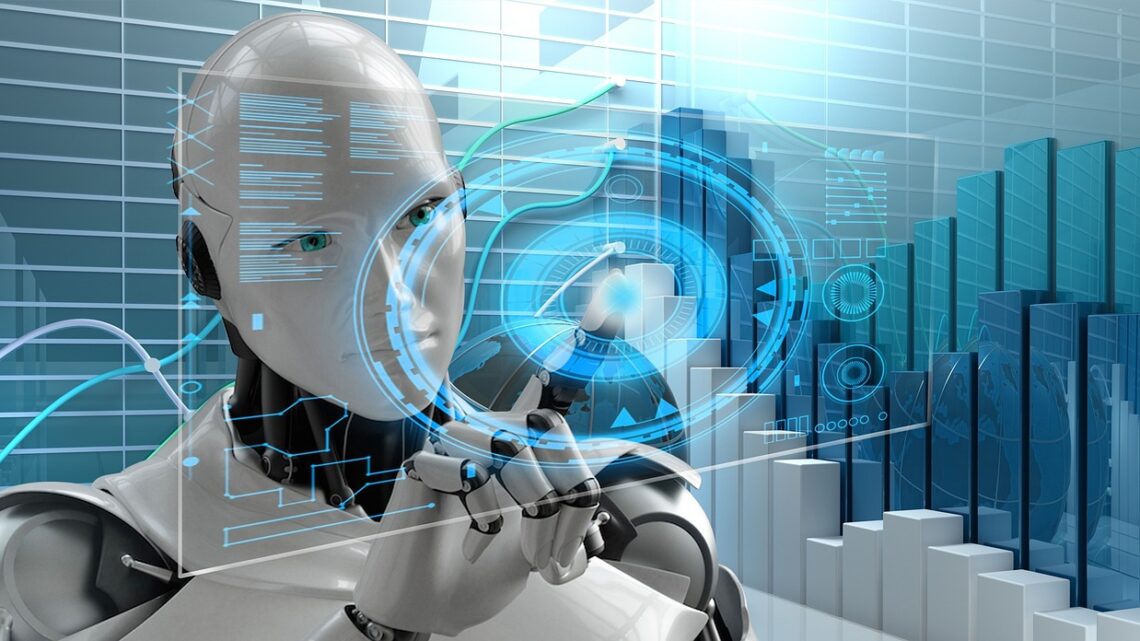What is Artificial Intelligence?
Artificial Intelligence (AI) is the field of computer science that involves building machines to think and act like humans. AI is an interdisciplinary field that combines elements from computer science, mathematics, psychology, linguistics, neuroscience, and philosophy to create intelligent machines that can perceive, reason, learn, and act.
In today’s world, AI is being used for a variety of applications, from automated personal assistants to self-driving cars. AI is rapidly transforming the way we live, enabling us to make better decisions, automate mundane tasks, and discover new patterns and insights.
AI systems are powered by algorithms, which are sets of instructions that tell the computer how to process data. Algorithms can be trained to recognize patterns, classify objects, and make predictions. In addition, they can be programmed to respond to user input and respond with the correct output.
At its core, AI is about creating machines that can think and act like humans. By leveraging the power of algorithms and data, AI systems can be trained to solve complex problems, understand natural language, and even recognize faces and objects in images.
History of Artificial Intelligence
AI has been around for decades, but its popularity has skyrocketed in recent years. AI was first conceptualized in the 1950s by a group of computer scientists and mathematicians who believed that machines could be trained to think and learn like humans.
Over the years, AI technology has advanced significantly, particularly in the areas of natural language processing, computer vision, speech recognition, and robotics. Today, AI is being used for a variety of applications in areas such as healthcare, finance, retail, and transportation.
In addition, AI has become increasingly accessible, with the development of easy-to-use AI development platforms and services. This has enabled developers to quickly create AI-powered applications and services, reducing the time and cost associated with AI development.
Types of Artificial Intelligence
There are many different types of AI systems, each with its own set of capabilities and applications. Some of the most common types of AI include:
- Machine Learning: Machine learning is a form of AI that enables machines to improve their performance by learning from data and experience.
- Natural Language Processing (NLP): NLP is a form of AI that enables machines to understand and interpret human language.
- Computer Vision: Computer vision is a form of AI that enables machines to recognize objects and images in digital images or videos.
- Robotics: Robotics is a form of AI that enables machines to perform physical tasks, such as moving objects or navigating an environment.
- Expert Systems: Expert systems are AI systems that are capable of making decisions and solving complex problems.
Benefits of Artificial Intelligence
AI has a wide range of applications and can provide a variety of benefits. Here are some of the main benefits of using AI:
- Increased Efficiency: AI systems can automate mundane tasks, freeing up human resources and allowing companies to focus on more important tasks.
- Improved Decision-Making: AI systems can provide insights into data that would be too complex or time-consuming for humans to process. This can help organizations make more informed decisions.
- Increased Productivity: AI systems can be used to increase productivity by automating processes and tasks.
- Reduced Costs: AI systems can help reduce costs by automating processes and reducing human error.
- Improved Customer Experience: AI can be used to improve customer experience by providing personalized experiences and recommendations.
- Safety: AI systems can be used to improve safety by detecting potential hazards and providing warnings.
- Increased Accuracy: AI systems can provide accurate results in areas such as image recognition, natural language processing, and decision-making.
Challenges of Artificial Intelligence
Despite the many benefits of AI, there are some challenges associated with AI development. Here are some of the main challenges of using AI:
- Data Quality: AI systems require large amounts of data to be effective. This data must be of high quality to ensure accurate results.
- Security: Data security is a major challenge for AI systems, as they are vulnerable to malicious attacks.
- Privacy: AI systems can collect and store large amounts of personal data, raising concerns about privacy.
- Explainability: AI systems can be difficult to explain, as they often make decisions based on complex algorithms.
- Bias: AI systems can be prone to bias, as they are trained using data that may be skewed.
Steps to Developing Artificial Intelligence
Developing an AI system requires a lot of planning and preparation. Here are the steps you need to take to develop an AI system:
- Identify Your Goals: Before beginning any AI development project, you must identify your goals and objectives. This will help ensure your project is successful.
- Gather Data: Next, you must gather the data you need to train your AI system. This data should be of high quality and represent the real-world situation you are trying to model.
- Pre-process Data: Before training your AI system, you must pre-process the data. This involves cleaning the data to remove any irrelevant or incorrect information.
- Select a Model: Once you have pre-processed the data, you must select an AI model that is suitable for your project.
- Train the Model: After selecting a model, you must train it using the data you have collected. This process may take some time, depending on the complexity of the model.
- Test the Model: Once the model has been trained, you must test it to ensure it is performing as expected.
- Deploy the Model: Finally, you must deploy the model into production. This will enable it to be used in the real world.
Artificial Intelligence Use Cases
AI can be used for a wide range of applications. Here are some of the most common AI use cases:
- Automation: AI can be used to automate mundane tasks, such as data entry, customer service, and inventory management.
- Image Recognition: AI can be used to recognize objects and faces in digital images and videos.
- Natural Language Processing: AI can be used to understand and interpret natural language.
- Predictive Analytics: AI can be used to analyze large amounts of data and make predictions about future events.
- Robotics: AI can be used to control robots and automate physical tasks.
- Recommender Systems: AI can be used to provide personalized recommendations to customers.
- Autonomous Vehicles: AI can be used to power self-driving cars and other autonomous vehicles.
Resources for AI Development
Developing an AI system can be difficult and time-consuming. Thankfully, there are a number of resources available to help you get started. Here are some of the main resources for AI development:
- AI Platforms: AI platforms are cloud-based services that provide the tools and frameworks needed to develop AI systems.
- AI Development Tools: AI development tools are software programs that enable developers to quickly create AI-powered applications and services.
- AI Development Services: AI development services are companies that specialize in AI development and can provide support throughout the development process.
- AI Documentation: AI documentation is a collection of tutorials and resources that can help developers learn how to develop AI systems.
- AI Conferences: AI conferences are events that bring together experts in the field of AI to share ideas and best practices.
AI Development Tools
AI development tools are essential for creating AI-powered applications and services. Here are some of the most popular AI development tools:
- TensorFlow: TensorFlow is an open-source AI framework that enables developers to quickly create and deploy AI models.
- Keras: Keras is a high-level neural network API that enables developers to quickly create and deploy deep learning models.
- PyTorch: PyTorch is an open-source deep learning framework that enables developers to build and deploy AI models.
- Scikit-learn: Scikit-learn is an open-source machine learning library that enables developers to quickly create and deploy AI models.
- Microsoft Cognitive Services: Microsoft Cognitive Services is a collection of AI services that enables developers to quickly create and deploy AI applications.
AI Development Services
AI development services can help you throughout the AI development process. Here are some of the most popular AI development services:
- Google Cloud AI Platform: Google Cloud AI Platform is a cloud-based service that enables developers to quickly create and deploy AI models.
- Amazon SageMaker: Amazon SageMaker is a cloud-based service that enables developers to quickly create and deploy AI models.
- Microsoft Azure Machine Learning: Microsoft Azure Machine Learning is a cloud-based service that enables developers to quickly create and deploy AI models.
- IBM Watson: IBM Watson is a cloud-based service that enables developers to quickly create and deploy AI models.
- Salesforce Einstein: Salesforce Einstein is a cloud-based service that enables developers to quickly create and deploy AI models.
Conclusion
AI is transforming the way we live and work, enabling us to make better decisions, automate mundane tasks, and discover new patterns and insights. To unlock the benefits of AI, developers need to understand the basics of AI development, select the right AI development tools and services, and develop AI systems that are secure, explainable, and free from bias. With the right resources and tools, developers can quickly create AI-powered applications and services that can improve efficiency, increase productivity, and provide better customer experiences.





